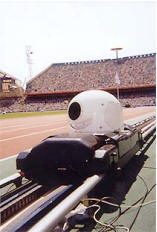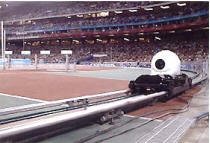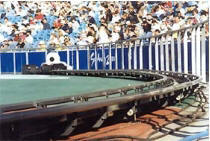PU
timing belts drive high-speed cameras
 "On
your marks, get set, go!" Who could fail to remember the exciting
television pictures of the fastest legs in the world belting past on
the Tartan track of the Olympic stadium at Sydney 2000? Appearing
almost within touching distance, the accompanying high-speed running
and jumping event cameras supplied us with a new dimension of
pictures right into our lounge. It was with astonishment that we
looked down on the pole-vaulter from above, swam alongside the
leading competitor in the swimming pool and enjoyed the remarkable
new sensation of actually seeing the drops of sweat on the face of
the leading long-distance runner. "On
your marks, get set, go!" Who could fail to remember the exciting
television pictures of the fastest legs in the world belting past on
the Tartan track of the Olympic stadium at Sydney 2000? Appearing
almost within touching distance, the accompanying high-speed running
and jumping event cameras supplied us with a new dimension of
pictures right into our lounge. It was with astonishment that we
looked down on the pole-vaulter from above, swam alongside the
leading competitor in the swimming pool and enjoyed the remarkable
new sensation of actually seeing the drops of sweat on the face of
the leading long-distance runner.
All this has been made possible by a camera control system which was
tested for the first time at the 1992 Olympic Games in Barcelona and
which has been perfected even further during each and every Olympic
summer and winter games since then. At the British Formula 1 Grand
Prix the camera moved alongside Michael Schumacher's Ferrari in the
pits, recorded the "thwack“ of the yellow balls at Wimbledon and
followed the sensational stage show of Madonna.
 A
major
contribution in the development of the drive and control system of
this camera
was made by Transmission Developments, the English member of the
MULCO EWIV Group of Companies. This system can best be imagined as a
short railway line on which the gyro-stabilised TV camera, weighing
125 kg including frame, is accelerated and braked in a UFO-type
special housing by remote control, reaching acceleration speeds of
up to 8m/s². The constant speed during uniform movement is in the
region of 14m/s, while the driving servomotor has a torque of 80 Nm. A
major
contribution in the development of the drive and control system of
this camera
was made by Transmission Developments, the English member of the
MULCO EWIV Group of Companies. This system can best be imagined as a
short railway line on which the gyro-stabilised TV camera, weighing
125 kg including frame, is accelerated and braked in a UFO-type
special housing by remote control, reaching acceleration speeds of
up to 8m/s². The constant speed during uniform movement is in the
region of 14m/s, while the driving servomotor has a torque of 80 Nm.
Transferring
these forces is the task of the PU timing belts which, thanks to
their almost ideal characteristics, were chosen in preference to
chain drives. Apart from the torque transfers, it was not only the
enormous lengths of the timing belts, measuring in excess of 200 m
for a 100 m track and the final bend which had to be taken into
account, but also the many other influences such as dust and
moisture from the jumping pits and tracks. It goes without saying
that absolutely uniform and smooth running as well as gentle
movements of the camera have to be guaranteed. Shaky pictures would
certainly spoil the pleasure of the viewing public, while the
environmental influences should not be underestimated either, as
dust and sand from the jumping pits will turn into a thick brew when
it rains.
 Even
the preparations for "Operation Sydney“ make impressive reading.
Five months were required for the design, construction and dispatch
of the 8 systems used during the Olympic games. 16.5 t of equipment,
packed in four large sea-freight containers, were flown around the
globe to the land of the kangaroos by Boeing 747, where 16
specialists took over the construction. By this stage a number of
development stages and test runs with PU timing belts from the MULCO
EWIV member BRECO had already been carried out at Transmission
Developments, ultimately resulting in the 20 AT10 belts for the
straight and final track as well as 25 AT10 belts for the last 100 m
of the straight. Even
the preparations for "Operation Sydney“ make impressive reading.
Five months were required for the design, construction and dispatch
of the 8 systems used during the Olympic games. 16.5 t of equipment,
packed in four large sea-freight containers, were flown around the
globe to the land of the kangaroos by Boeing 747, where 16
specialists took over the construction. By this stage a number of
development stages and test runs with PU timing belts from the MULCO
EWIV member BRECO had already been carried out at Transmission
Developments, ultimately resulting in the 20 AT10 belts for the
straight and final track as well as 25 AT10 belts for the last 100 m
of the straight.
When you consider the forces and external influences that the
endless timing belt for straights and final bends alone, the longest
at 420 m, is subjected to, the supreme characteristics of PU timing
belts become apparent even under these unconventional conditions:
-
Highly wear resistant
-
Largely resistant to oils, grease, alkaline and abrasive dusts
-
Slip and shock-free
-
Silent running
During the Olympic year of 2002 the moving cameras and other
locations supplied exciting pictures of competing athletes on the
long-distance track or in the ice oval at Salt Lake City, as well as
at the Commonwealth Games. We can therefore look forward to
continuing to receive fascinating television pictures achieved by
the convincing know-how of the MULCO EWIV Group of Companies, which
celebrated its 50-year anniversary in 2001.
|